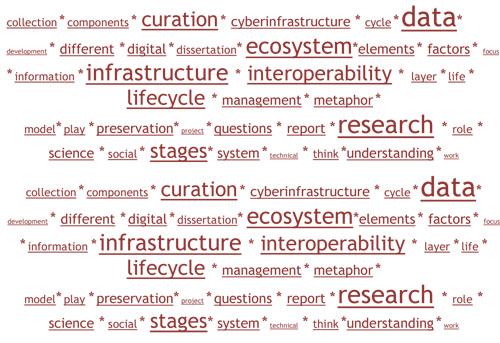By Inna Kouper
We’re focusing on data during the second week of CLIR’s two-week immersion seminar for postdoctoral fellows at beautiful Bryn Mawr College. We talk about data production, data curation, data management, data stewardship, and so on. We engage with a spectacular range of guests who are deeply involved with practices and conceptualizations of data curation, read a lot, and talk.
Here are some recurring themes from our conversations:
Diversity. It’s everywhere: in the fellows’ backgrounds, in guests’ experiences and affiliations, and, of course, in data and approaches to its curation. Data differ in size, format, level of cleanliness/messiness, definition, policy, and more. On top of all that we have a “terrible language problem” (Clifford Lynch), i.e., we all may be talking about the same thing, but we use different vocabularies.
Role of the library. All participants of this seminar agree that libraries are important. But what is their role? Do they focus on development and innovation in their services, or collections, or infrastructure—or do they work in all of these directions concurrently?
(Cyber)infrastructures. A lot has already been done in this area—development of standards, models, gateways, and software/hardware solutions. And yet there is much more to be done because adoption of data curation and archival practices is very slow. Why? The short answer is: people. For a long answer, start by reading Understanding Infrastructures: Dynamics, Tensions, and Designs, by P. Edwards, S. Jackson, G. Bowker, and C. Knobel.
Tensions. Data curation and stewardship involve universities, libraries, granting agencies, and creative individuals who share the ideals of openness, sharing, preservation, and reuse. At the same time they have different cultures and practices. Tensions might be institutional, individual, or disciplinary. They are inevitable, but we need mechanisms of turning tensions into solutions, rather than roadblocks and dead ends. The conversation about mechanisms leads to the next theme—interdisciplinarity and collaborations.
Interdisciplinarity and collaborations. Despite, or perhaps due to, great diversity, tensions, and uncertainties, we look for and find solutions in working together. Consolidating local systems and tools, building gateways, relying on the so-called boundary workers (people who build bridges between and translate across domains and institutions), and being open and flexible will pay off in the future. As Chuck Humphrey, head of the Data Library and academic director of the Alberta Research Data Centre, put it, we need to overcome “extreme individualism” and recognize that the emerging digital environments are possible only through collaboration and multi-institutional support. At the same time, individuals with vision, creativity, leadership, and desire to reach out and connect who are placed at the center of interactions are crucial.
This seminar will end soon, but it is just a beginning of new partnerships, ideas, and data curation initiatives. If you are involved with data and its curation, where do you see yourself in 3, 5, or 10 years?
Guest blogger Inna Kouper is a 2012-14 CLIR/DLF Data Curation Postdoctoral Fellow. She is recent Ph.D. graduate from the school of Library and Information Science at Indiana University, Bloomington.


